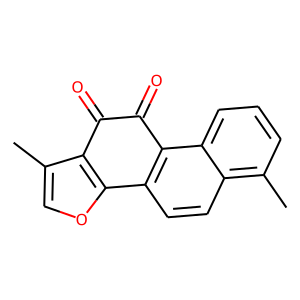Compound Description
| ID: C0427 | Common name: Tanshinone I |
| IUPAC: 1,6-dimethylnaphtho[1,2-g][1]benzofuran-10,11-dione | CAS: CAS:568-73-0 |
| Chembl ID: CHEMBL363535 | Pubchem ID: CID:114917 |
| Formula: C18H12O3 | TCM-ID: TCMC2126 |
| Smiles: CC1=C2C=CC3=C(C2=CC=C1)C(=O)C(=O)C4=C3OC=C4C | |
| Alias:
1,6-Dimethylphenanthro[1,2-b]furan-10,11-dione;
Tanshinon I; Tanshinone A; Tanshinone I |
Structure:

|
Related Targets (Total: 10)
| Target id | Protein Name | Gene Symbol | Uniprot ID | Target Level | No.of Literature Evidence |
|---|---|---|---|---|---|
| T43G0N | Cytochrome P450 2C8 | CYP2C8 |
P10632 |
A | 1 Reference(s) |
| T69XEM | Tyrosine-protein kinase SYK | SYK |
P43405 |
A | 1 Reference(s) |
| T70HTD | Cytochrome P450 2E1 | CYP2E1 |
P05181 |
A | 1 Reference(s) |
| T02QBS | Cytochrome P450 1A2 | CYP1A2 |
P05177 |
A | 1 Reference(s) |
| T69RXK | Cytochrome P450 2C9 | CYP2C9 |
P11712 |
A | 1 Reference(s) |
| T85AXP | Cytochrome P450 3A4 | CYP3A4 |
P08684 |
A | 1 Reference(s) |
| T06RMZ | Nuclear factor NF-kappa-B p105 subunit | NFKB1 |
P19838 |
B | 1 Reference(s) |
| T10HL8 | Intercellular adhesion molecule 1 | ICAM1 |
P05362 |
C | 1 Reference(s) |
| T42EAZ | Vascular endothelial growth factor A | VEGFA |
P15692 |
C | 1 Reference(s) |
| T59IKQ | Vascular cell adhesion protein 1 | VCAM1 |
P19320 |
C | 1 Reference(s) |
*In this table, target level represents the quality confidence indicators of targets.
Level 'A' represents "Directly inhibit/activate".
Level 'B' represents "Indirectly inhibit/ activate", "Enzyme substate" and "Enzyme product".
Level 'C' represents "Up/Down regulation" and "Others".
Level 'A' represents "Directly inhibit/activate".
Level 'B' represents "Indirectly inhibit/ activate", "Enzyme substate" and "Enzyme product".
Level 'C' represents "Up/Down regulation" and "Others".
Related Herbs (Total: 9)
| Herb id | Chinese Pin Yin | Chinese Character | English Name | Latin Name |
|---|---|---|---|---|
| H1186 | Hong Gen Cao | 红根草 | Hispid sage | Salvia prionitis |
| H0845 | Zi Dan Shen | 紫丹参 | Manchurian sage | Salvia przewalskii var. mandarinorum |
| H0949 | Dan Shen | 丹参 | The root of red-rooted salvia | Salvia miltiorrhiza |
| H0323 | Qian Hu | 前胡 | Common hogfennel | Angelica decursiva |
| H0950 | Dan Shen Gan Jin Gao | 丹参干浸膏 | The root of red-rooted salvia | Salvia miltiorrhiza |
| H0951 | Dan Shen Jin Gao | 丹参浸膏 | The root of red-rooted salvia | Salvia miltiorrhiza |
| H0461 | Shi Jun Zi Ren | 使君子仁 | NA | Combretum indicum |
| H0632 | Xia Ku Cao | 夏枯草 | Common selfheal | Prunella vulgaris |
| H1229 | Bai Mu Xiang | 白木香 | Chinese eaglewood | Aquilaria sinensis |
Ckey description of the interaction between compound and target